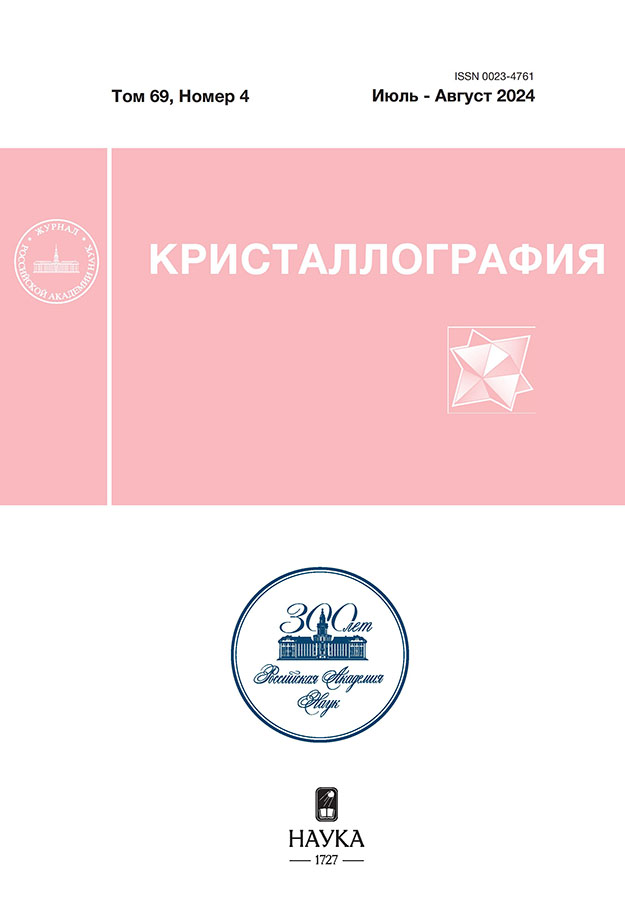Structure of inorganic compounds halogen bonds in derivatives of 2,5-diiod-1,4-dimethylbenzene
- 作者: Rajakumar K.1, Zherebtsov D.A.1, Nayfert S.А.1, Osipov A.А.1, Adonin S.A.1,2, Spiridonova D.V.3
-
隶属关系:
- South Ural State University
- A. E. Favorsky Irkutsk Institute of Chemistry SB RAS
- St. Petersburg State University
- 期: 卷 69, 编号 4 (2024)
- 页面: 612-619
- 栏目: STRUCTURE OF ORGANIC COMPOUNDS
- URL: https://permmedjournal.ru/0023-4761/article/view/673149
- DOI: https://doi.org/10.31857/S0023476124040062
- EDN: https://elibrary.ru/XDHKLT
- ID: 673149
如何引用文章
详细
The synthesis of 1,4-di(bromomethyl)-2,5-diiodo-benzene (1), diacetate of 2,5-diiodo–1,4-di(hydroxymethyl)benzene (2) and diiodide of 1,1’-[(2,5-diiodo-1,4-phenylene)bis(methylene)]dipyridinium (3) is described and their crystallographic data are given. All three crystal structures are characterized by the stacked packing of planar molecules and the presence of halogen bonds I–Br, I–O, and I–I, respectively. The number of halogen bonds is maximum in compound 1: two I–Br bonds for each halogen atom. Compounds 2 and 3 contain one halogen bond per halogen atom, but they are significantly shorter than in compound 1. All crystals were investigated by IR spectroscopy and synchronized thermal analysis. Compound 1, which has no ionic or hydrogen bonds, melts at a higher temperature than ionic compound 3 (218 and 200°C, respectively) due to the presence of a large number of intermolecular halogen bonds. Compound 2 melts at a lower temperature (151°C), which is characteristic of esters.
全文:
作者简介
K. Rajakumar
South Ural State University
Email: zherebtcovda@susu.ru
俄罗斯联邦, Chelyabinsk
D. Zherebtsov
South Ural State University
编辑信件的主要联系方式.
Email: zherebtcovda@susu.ru
俄罗斯联邦, Chelyabinsk
S. Nayfert
South Ural State University
Email: zherebtcovda@susu.ru
俄罗斯联邦, Chelyabinsk
A. Osipov
South Ural State University
Email: aaosipov@susu.ru
俄罗斯联邦, Chelyabinsk
S. Adonin
South Ural State University; A. E. Favorsky Irkutsk Institute of Chemistry SB RAS
Email: zherebtcovda@susu.ru
俄罗斯联邦, Chelyabinsk; Irkutsk
D. Spiridonova
St. Petersburg State University
Email: zherebtcovda@susu.ru
Научный парк
俄罗斯联邦, St. Petersburg参考
- Cavallo G., Metrangolo P., Milani R. et al. // Chem. Rev. 2016. V. 116. P. 2478. https://doi.org/10.1021/acs.chemrev.5b00484
- Mikherdov A.S., Novikov A.S., Boyarskiy V.P et al. // Nature Commun. 2020. V. 11. 2921. https://doi.org/10.1038/s41467-020-16748-x
- Matveychuk Y.V., Ilkaeva M.V., Vershinina E.A. et al. // J. Mol. Struct. 2016. V. 1119. P. 227. https://doi.org/10.31857/S0044457X21100202
- Yushina I., Tarasova N., Kim D. et al. // Crystals. 2019. V. 9. P. 506. https://doi.org/10.3390/cryst9100506
- Albright E., Cann J., Decken A. et al. // Cryst. Eng. Commun. 2017. V. 19. P. 1024. https://doi.org/10.1039/C6CE02339H
- Baykov S.V., Filimonov S.I., Rozhkov A.V. et al. // Cryst. Growth Des. 2020. V. 20. P. 995.
- Albietz P.J., Cleary B.P., Paw W. et al. // J. Am. Chem. Soc. 2001. V. 123. P. 12091. https://doi.org/10.1021/ja016127l
- Albietz P.J., Cleary B.P., Paw W. et al. // Inorg. Chem. 2002. V. 41. P. 2095. https://doi.org/10.1021/ic025506s
- Rajakumar K., Sharutin V.V., Adonin S.A. et al. // J. Struct. Chem. 2022. V. 63. P. 620. https://doi.org/10.1134/S0022476622040138
- Grunder S., Huber R., Horhoiu V. et al. // J. Org. Chem. 2007. V. 72. P. 8337. https://doi.org/10.1021/jo7013998
- Gaefke G., Enkelmann V., Höger S. // Synthesis. 2006. V. 17. P. 2971. https://doi.org/10.1055/s-2006-942534
- Costa A.L., Ferreira L.F., Prata J.V. // J. Polym. Sci. A. Polym. Chem. 2008. V. 46. P. 6477. https://doi.org/10.1002/pola.22957
- Hodecker M., Kozhemyakin Y., Weigold S. et al. // Chem. Eur. J. 2020. V. 26. P. 16990. https://doi.org/10.1002/chem.202002552.
- Jordan R.S., Wang Y., McCurdy R.D. et al. // Chem. 2016. V. 1. P. 78. https://doi.org/10.1016/j.chempr.2016.06.010
- Fan Q.-L., Lu S., Lai Y.-H. et al. // Macromolecules. 2003. V. 36. P. 6976. https://doi.org/10.1021/ma030093f
- Nishinaga S., Sawanaka Y., Toyama R. et al. // Chem. Lett. 2018. V. 47. P. 1409. https://doi.org/10.1246/cl.180644
- Horváth D.V., Holczbauer T., Bereczki L. et al. // CrystEngComm. 2018. V. 13. https://doi.org/10.1039/c8ce00041g
- CrysAlisPro 1.171.41.103a (Rigaku Oxford Diffraction, 2021).
- Dolomanov O.V., Bourhis L.J., Gildea R.J. et al. // J. Appl. Cryst. 2009. V. 42. P. 339. https://doi.org/10.1107/S0021889808042726
- Sheldrick G.M. // Acta Cryst. A. 2015. V. 71. P. 3. https://doi.org/10.1107/S2053273314026370
- Sheldrick G.M. // Acta Cryst. C. 2015. V. 71. P. 3. https://doi.org/10.1107/S2053229614024218
- Mantina M., Chamberlin A.C., Valero R. et al. // J. Phys. Chem. A. 2009. V. 113. P. 5806. https://doi.org/10.1021/jp8111556
补充文件














